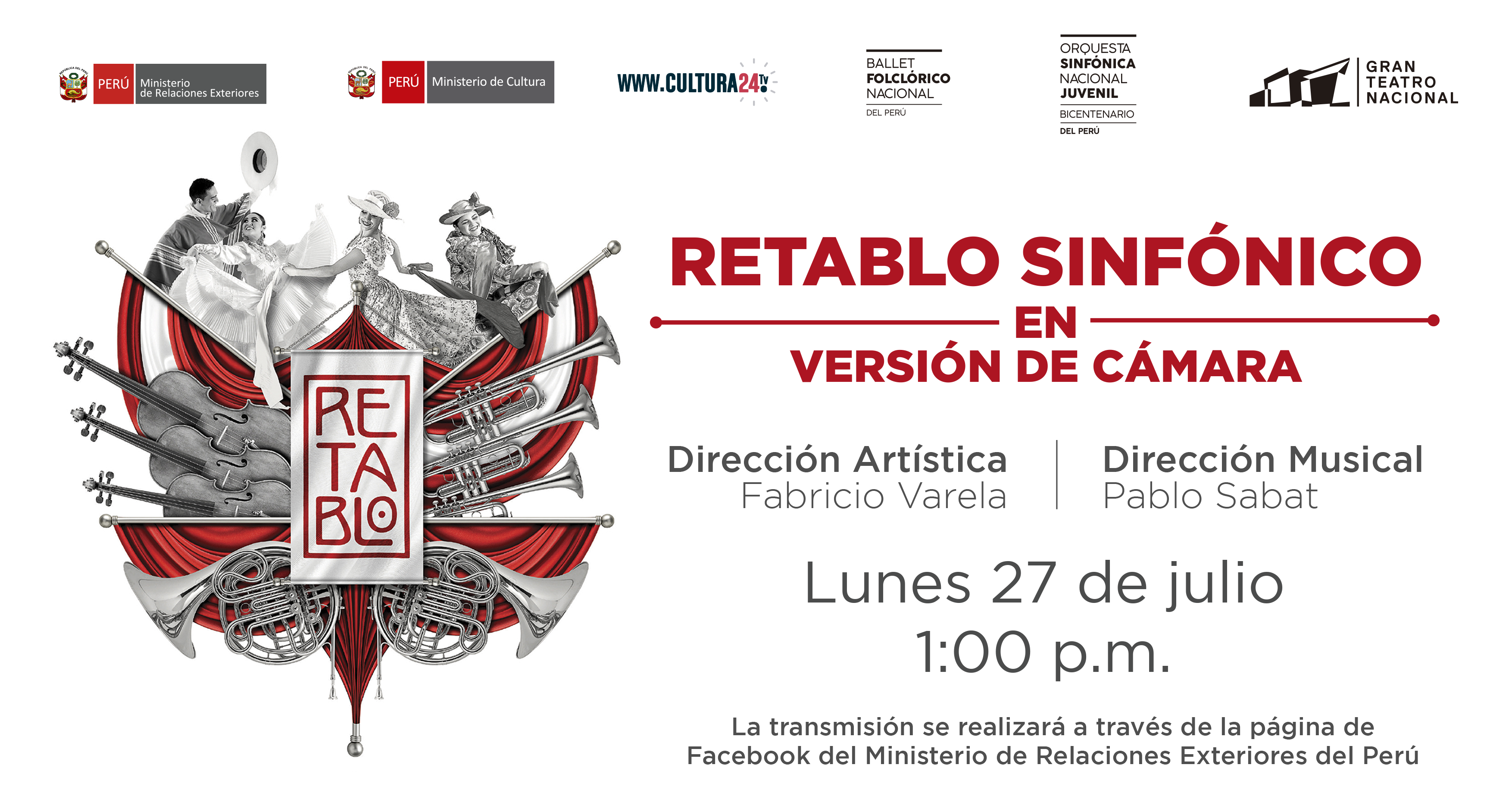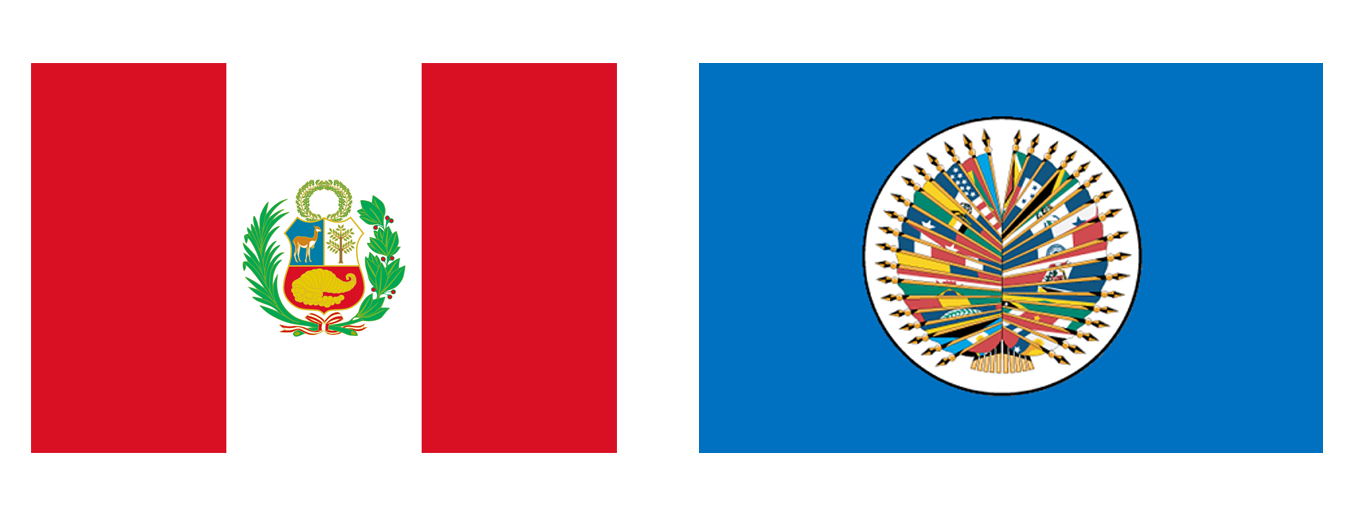
FIESTAS PATRIAS 2020
Retablo Sinfónico - EN VERSIÓN DE CÁMARA
Como parte de las celebraciones por nuestro 199º aniversario patrio, presentación por el Ministerio de Cultura del Perú, desde el Gran Teatro Nacional, del “Retablo Sinfónico - en versión de cámara”.
Propuesta artística creada por el Ballet Folclórico Nacional y la Orquesta Sinfónica Nacional Juvenil Bicentenario.
El espectáculo propone un recorrido por cuatro regiones del país a través de cuadros inspirados en nuestro folclore, que unidos a instrumentos sinfónicos, invita a disfrutar parte de nuestro orgullo de ser peruanos.
¡Felices Fiestas Patrias!
Creación y dirección Artística: Fabricio Varela Travesí
Dirección Musical: Pablo Sabat Mindreau
PROGRAMA
- Cuadro Limeño (Vals, One-step y Polka)
- Cuadro Amazónico (Io Patati, Fiesta de los Tulumayos y Carnaval de Lamas)
- Cuadro Afroperuano (Toromata, Zamacueca y Oita Nomá)
- Cuadro Arequipeño (Carnaval de Arequipa)
I. CUADRO AMAZÓNICO
Io Patati es una recreación coreográfica proveniente del departamento de Ucayali que pertenece a la etnia Shipibo-Conibo. Esta danza ritual guerrera era interpretada antes o después de sangrientas batallas entre las comunidades nativas amazónicas, como preparación para la pelea o celebración por la victoria. Las mujeres acompañaban con la elaboración del masato y otras clases de bebidas para infundir en los guerreros fuerza y coraje.
La Fiesta de los Tulumayos de Huánuco se basa en las celebraciones de esta comunidad amazónica ubicada entre los ríos Topa y Tulumayo. Hombres y mujeres, con los rostros pintados con líneas que hacían referencia a su descendencia o territorio, se reunían alrededor de grandes fogatas para protegerse del frío, narrando aventuras mediante el baile y la música. Esta danza se recuerda durante la Fiesta de San Juan.
Una de las celebraciones más famosas de nuestra Amazonía es el Carnaval de Lamas, de la región San Martín, que festeja la vida, agradece por los frutos recibidos e impulsa un año bueno. Esta coreografía recoge ese ambiente de alegría multicolor.
II. CUADRO AREQUIPEÑO
El Carnaval de Arequipa es una celebración festiva que se ha convertido en la representación de la identidad cultural de esa ciudad. Durante varios días muestra la vestimenta, las alegorías y las parafernalias que pintan colores las plazas y calles. La música para este carnaval fue recopilada por el reconocido compositor Benigno Ballón Farfán. En 2018, su obra fue declarada Patrimonio Cultural de la Nación.
III. CUADRO LIMEÑO
Dentro de nuestro repertorio criollo encontramos múltiples expresiones artísticas, entre ellas el vals, one-step y la polka. Estas tres manifestaciones provienen de influencias europeas y americanas que se desarrollaron a finales del siglo XIX, consolidándose como géneros musicales en las primeras décadas del siglo XX. Uno de los compositores criollos más destacados fue Felipe Pinglo, quien llegó a elaborar más de 500 canciones retratando la vida cotidiana de la época.
IV. CUADRO AFROPERUANO
El Toro mata es una de las expresiones artísticas más populares dentro del bagaje cultural afroperuano. Aunque existe una versión anterior, una de las recopilaciones más conocidas es la presentada por Carlos ‘Caitro’ Soto de la Colina (1973). La primera grabación de esta pieza la realizó la cantante peruana Cecilia Barraza a inicios de la década de los setenta, años posteriores la interpretó la notable Celia Cruz.
Otra pieza del folclore afroperuana es la Zamacueca, un baile de pareja pícaro y sensual que representa el cortejo del hombre hacia la mujer. Se desarrolló en la época del virreinato peruano, producto del mestizaje entre los gitanos y mulatos que habitan en esa época, encontrando sus más antiguas representaciones durante los siglos XVI y XVI.
Oita nomá es una danza satírica que, mediante movimientos entretenidos y jocosos, retrata la faena diaria de los esclavos negros durante sus labores domésticas. Desde su perspectiva buscan representar la cultura de los ciudadanos españoles, narrando impresiones que obtuvieron producto del acercamiento a las costumbres y festejos de sus amos.
NATIONAL DAY OF PERU
Bicentennial National Youth Symphony Orchestra, under the artistic direction of Fabricio Varela and the musical direction of Pablo Sabat. – IN CHAMBER VERSION
As part of the celebrations for our 199th national anniversary, the Ministry of Culture of Peru presents from the Grand National Theater "Symphonic Altarpiece - in chamber version", an artistic proposal created by the National Folkloric Ballet and the Bicentennial National Youth Symphony Orchestra. This show proposes a journey across four regions of the country through scenes inspired by our folklore, which together with symphonic instruments, invites us to enjoy part of our pride in being Peruvian.
Happy National Holidays!
Creation and Artistic Direction: Fabricio Varela Travesí
Musical Direction: Pablo Sabat Mindreau
PROGRAMME
- Limeño Scene (Waltz, One-step and Polka)
- Amazon Scene (Io Patati, Tulumayos Celebration and Lamas Carnival)
- Afro-Peruvian Scene (Toromata, Zamacueca and Oita Nomá)
- Arequipeño Scene (Arequipa Carnival)
I. AMAZON SCENE
Io Patati is a choreographic recreation from the department of Ucayali that belongs to the Shipibo-Conibo ethnic group. This ritual warrior dance was performed before or after bloody battles between the native Amazon communities, in preparation for the fight or celebration of victory. The women accompanied with the elaboration of masato and other kinds of drinks to infuse the warriors with strength and courage.
The Feast of the Tulumayos of Huánuco is based on the celebrations of this Amazon community located between the Topa and Tulumayo rivers. Men and women, with faces painted with lines that made reference to their descendants or their territory, gathered around large bonfires to protect themselves from the cold, telling adventures through dance and music. This dance is remembered during the San Juan Feast.
One of the most famous celebrations in our Amazon is the Lamas Carnival, of the San Martín region, which celebrates life, acknowledges for the fruits received and promotes a good year. This choreography reflects that atmosphere of multicoloured joy.
II. AREQUIPEÑO SCENE
The Arequipa Carnival is a festive celebration that has become the representation of the cultural identity of that city. For several days it displays the clothing, allegories and paraphernalia that paint with colours the squares and streets. The music for this carnival was compiled by the renowned composer Benigno Ballón Farfán. In 2018, his work was declared Cultural Heritage of the Nation.
III. LIMEÑO SCENE
Within our Creole repertoire we find multiple artistic expressions, including waltz, one-step and polka. These three manifestations come from European and American influences that developed at the end of the 19th century, consolidating as musical genres in the first decades of the 20th century. One of the most outstanding Creole composers was Felipe Pinglo, who wrote more than 500 songs portraying the daily life of the time.
IV. AFRO-PERUVIAN SCENE
The Toro mata is one of the most popular artistic expressions within the Afro-Peruvian cultural context. Although there is an earlier version, one of the best-known compilations is the one presented by Carlos ‘Caitro’ Soto de la Colina (1973). The first recording of this piece was made by the Peruvian singer Cecilia Barraza at the beginning of the seventies; years later, it was performed by the remarkable Celia Cruz.
Another piece of Afro-Peruvian folklore is the Zamacueca, a mischievous and sensual couple dance that represents the courtship of the man towards the woman. It was developed at the time of the Peruvian viceroyalty, a product of the crossbreeding between the gypsies and mulattoes who lived at that time, finding its oldest representations during the 16th and 17th centuries.
Oita nomá is a satirical dance that, through entertaining and humorous movements, portrays the daily work of black slaves during their domestic chores. From their perspective, they seek to represent the culture of Spanish citizens, narrating impressions that they obtained as a result of the approach to the customs and festivities of their masters.


